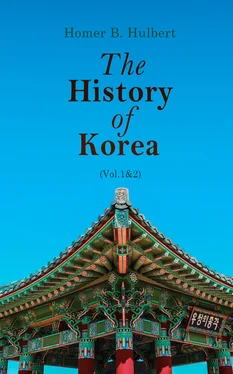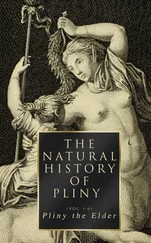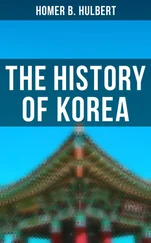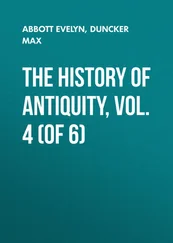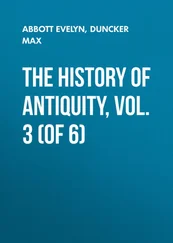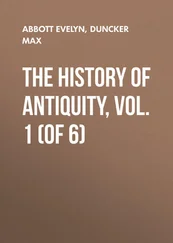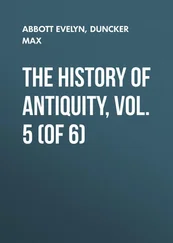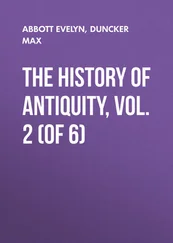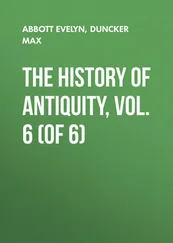Homer B. Hulbert - The History of Korea (Vol.1&2)
Здесь есть возможность читать онлайн «Homer B. Hulbert - The History of Korea (Vol.1&2)» — ознакомительный отрывок электронной книги совершенно бесплатно, а после прочтения отрывка купить полную версию. В некоторых случаях можно слушать аудио, скачать через торрент в формате fb2 и присутствует краткое содержание. Жанр: unrecognised, на английском языке. Описание произведения, (предисловие) а так же отзывы посетителей доступны на портале библиотеки ЛибКат.
- Название:The History of Korea (Vol.1&2)
- Автор:
- Жанр:
- Год:неизвестен
- ISBN:нет данных
- Рейтинг книги:3 / 5. Голосов: 1
-
Избранное:Добавить в избранное
- Отзывы:
-
Ваша оценка:
- 60
- 1
- 2
- 3
- 4
- 5
The History of Korea (Vol.1&2): краткое содержание, описание и аннотация
Предлагаем к чтению аннотацию, описание, краткое содержание или предисловие (зависит от того, что написал сам автор книги «The History of Korea (Vol.1&2)»). Если вы не нашли необходимую информацию о книге — напишите в комментариях, мы постараемся отыскать её.
The History of Korea (Vol.1&2) — читать онлайн ознакомительный отрывок
Ниже представлен текст книги, разбитый по страницам. Система сохранения места последней прочитанной страницы, позволяет с удобством читать онлайн бесплатно книгу «The History of Korea (Vol.1&2)», без необходимости каждый раз заново искать на чём Вы остановились. Поставьте закладку, и сможете в любой момент перейти на страницу, на которой закончили чтение.
Интервал:
Закладка:
Fantastic as this story seems, it may have an important bearing upon the question of the location of Pu-yŭ. Can we not see in this great shoal of fish a reference to the salmon which, at certain seasons, run up the Amur and its tributaries in such numbers that the water is literally crowded with them? If there is any weight to this argument the kingdom of Pu-yŭ, from which Chu-mong came, must have been, as some believe, along the Sungari or some other tributary of the Amur.
Leaving his brothers baffled on the northern bank, Chu-mong fared southward till he reached Mo-tun-gok by the Po-sul River where he met three men, Chă-sa, clothed in grass cloth, Mu-gol in priestly garb and Muk-hŭ, in seaweed. They joined his retinue and proceeded with him to Chŭl-bon, the present town of Song-ch’ŭn, where he founded a kingdom. He gave it the name of Ko-gu-ryŭ, from Ko, his family name, and Ku-ryŭ, a mountain in his native Pu-yŭ. Some say the Ko is from the Chinese Kao , “high,” referring to his origin. This kingdom is also known by the name Chŭl-bon Pu-yu. It is said that Pu-ryu River flowed by the capital. These events occurred, if at all, in the year 37 B.C. This was all Chinese land, for it was a part of the great province of Tong-bu which had been erected by the Emperor So-je (Chao-ti) in 81 B.C. Only one authority mentions Chu-mong’s relations with Tong-bu. This says that when he erected his capital at Chŭl-bon he seized Tong-bu. China had probably held these provinces with a very light hand and the founding of a vigorous native monarchy would be likely to attract the semi-barbarous people of northern Korea. Besides, the young Ko-gu-ryŭ did not seize the whole territory at once but gradually absorbed it. It is not unlikely that China looked with complacency upon a native ruler who, while recognising her suzerainty, could at the same time hold in check the fierce denizens of the peninsula.
We are told that the soil of Ko-gu-ryŭ was fertile and that the cereals grew abundantly. The land was famous for its fine horses and its red jade, its blue squirrel skins and its pearls. Chu-mong inclosed his capital in a heavy stockade and built store-houses and a prison. At its best the country stretched a thousand li beyond the Yalu River and southward to the banks of the Han. It comprised the Nang-nang tribe from which Emperor Mu-je named the whole north-western portion of Korea when he divided northern Korea into four provinces. On the east was Ok-ju and on its north was Pu-yŭ. It contained two races of people, one living among the mountains and the other in the plains. It is said they had a five-fold origin. There were the So-ro-bu, Chŭl-lo-bu, Sun-no-bu, Kwan-no-bu and Kye-ro-bu. The kings at first came from the So-ro-bu line but afterwards from the Kye-ro-bu. This probablyprobably refers to certain family clans or parties which existed at the time of Chu-mong’s arrival and which were not discontinued. Chu-mong is said to have married the daughter of the king of Chŭl-bon and so he came into the control of affairs in a peaceful way and the institutions of society were not particularly disturbed.
Agriculture was not extensively followed. In the matter of food they were very frugal. Their manners and customs were somewhat like those of Pu-yŭ but were not derived from that kingdom. Though licentious they were fond of clean clothes. At night both sexes gathered in a single apartment and immorality abounded. Adultery, however, if discovered, was severely punished. In bowing it was customary for these people to throw out one leg behind. While travelling, men more often ran than walked. The worship of spirits was universal. In the autumn there was a great religious festival. In the eastern part of the peninsula there was a famous cave called Su-sin where a great religious gathering occurred each autumn. Their religious rites included singing and drinking. At the same time captives were set free. They worshipped likewise on the eve of battle, slaughtering a bullock and examining the body for omens.
Swords, arrows and spears were their common weapons. A widow usually became the wife of her dead husband’s brother. When a great man died it was common to bury one or more men alive with his body. The statement that sometimes as many as a hundred were killed is probably an exaggeration. These characteristics were those of the Nang-nang people as well as of the rest of Ko-gu-ryŭ. The highest official grades were called Sang-ga-dă, No-p’ă, Ko-ju-dă. Some say their official grades were called by the names of animals, as the “horse grade” the “dog grade” the “cow grade.” There were special court garments of silk embroidered with gold and silver. The court hat was something like the present kwan or skull-cap. There were few prisoners. If a man committed a crime he was summarily tried and executed, and his wife and children became slaves. Thieves restored twelve-fold. Marriage always took place at the bride’s house. The dead were wrapped in silks and interred, and commonly the entire fortune of the deceased was exhaustedexhausted in the funeral ceremony. The bodies of criminals were left unburied. The people were fierce and violent and thieving was common. They rapidly corrupted the simpler and cleaner people of the Ye-măk and Ok-jŭ tribes.
No sooner had Chu-mong become firmly established in his new capital than he began to extend the limits of his kingdom. In 35 B.C. he began a series of conquests which resulted in the establishment of a kingdom destined to defy the power of China for three quarters of a millennium. His first operations were against the wild people to the east of him. The first year he took Pu-ryu on the Ya-lu, then in 29 B.C. he took Hăng-in, a district near the present Myo-hyang San. In 27 B.C. he took Ok-jŭ, thus extending his kingdom to the shore of eastern Korea. In 23 B.C. he learned that his mother had died in far off Pu-yŭ and he sent an embassy thither to do honor to her.
The year 18 B.C. beheld the founding of the third of the great kingdoms which held the triple sceptre of Korea, and we must therefore turn southward and examine the events which led up to the founding of the kingdom of Păk-je.
When Chu-mong fled southward from Pu-yŭ he left behind him a wife and son. The latter was named Yu-ri. Tradition says that one day while playing with pebbles in the street he accidentally broke a woman’s water jar. In anger she exclaimed “You are a child without a father.” The boy went sadly home and askedasked his mother if it was true. She answered yes, in order to see what the boy would do. He went out and found a knife and was on the point of plunging it into his body when she threw herself upon him saying “Your father is living and is a great king in the south. Before he left he hid a token under a tree, which you are to find and take to him.” The boy searched every where but could not find the tree. At last, wearied out, he sat down behind the house in despair, when suddenly he heard a sound as of picking, and noticing that it came from one of the posts of the house he said “This is the tree and I shall now find the token.” Digging beneath the post he unearthed the broken blade of a sword. With this he started south and when he reached his father’s palace he showed the token. His father produced the other half of the broken blade and as the two matched he received the boy and proclaimed him heir to the throne.
But he had two other sons by a wife whom he had taken more recently. They were Pi-ryu and On-jo. When Yu-ri appeared on the scene these two brothers, knowing how proverbially unsafe the head of a king’s relative is, feared for their lives and so fled southward. Ascending Sam-gak San, the mountain immediately behind the present Seoul, they surveyed the country southward. Pi-ryu the elder chose the country to the westward along the sea. On-jo chose to go directly south. So they separated, Pi-ryu going to Mi-ch’u-hol, now In-ch’ŭn near Chemulpo, where he made a settlement. On-jo struck southward into what is now Ch’ung-ch’ŭng Province and settled at a place called Eui-rye-sŭng, now the district of Chik-san. There he was given a generous tract of land by the king of Ma-han; and he forthwith set up a little kingdom which he named South Pu-yŭ. The origin of the name Păk-je is not definitely known. Some say it was because a hundred men constituted the whole of On-jo’s party. Others say that it was at first called Sip-je and then changed to Păk-je when their numbers were swelled by the arrival of Pi-ryu and his party. The latter had found the land sterile and the climate unhealthy at Mi-ch’u-hol and so was constrained to join his brother again. On the other hand we find the name Păk-je in the list of original districts of Ma-han and it is probable that this new kingdom sprang up in the district called Păk-je and this name became so connected with it that it has came down in history as Păk-je, while in truth it was not called so by its own people. It the same way Cho-sŭn is known today by the medieval name Korea. Not long after Pi-ryu rejoined his brother he died of chagrin at his own failure.
Читать дальшеИнтервал:
Закладка:
Похожие книги на «The History of Korea (Vol.1&2)»
Представляем Вашему вниманию похожие книги на «The History of Korea (Vol.1&2)» списком для выбора. Мы отобрали схожую по названию и смыслу литературу в надежде предоставить читателям больше вариантов отыскать новые, интересные, ещё непрочитанные произведения.
Обсуждение, отзывы о книге «The History of Korea (Vol.1&2)» и просто собственные мнения читателей. Оставьте ваши комментарии, напишите, что Вы думаете о произведении, его смысле или главных героях. Укажите что конкретно понравилось, а что нет, и почему Вы так считаете.
